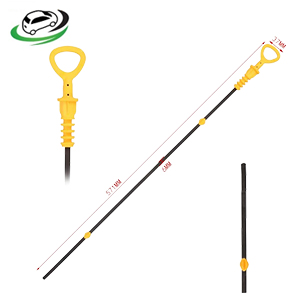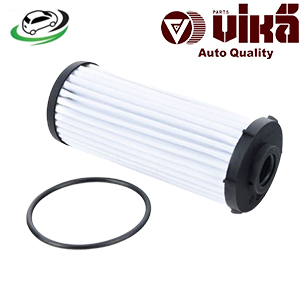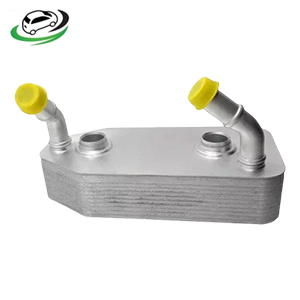Get Automatic Transmission Oil Cooler AUDI A3 (8L1) / VW Golf IV/Golf III Cabriolet/Golf III/Bora I/Golf V/Vento (1H2)/POLO III 096409061G
The automatic transmission oil cooler is a vital component in modern vehicles, ensuring that the transmission operates within safe temperature limits. Overheating can lead to transmission failure, reduced performance, and increased maintenance costs. This comprehensive guide covers the function, design, common issues, and maintenance of the automatic transmission oil cooler.
1. Purpose and Function of the Automatic Transmission Oil Cooler
The primary role of the automatic transmission oil cooler is to maintain the optimal operating temperature of the transmission fluid. Transmission fluid serves multiple functions, including lubrication, cooling, and hydraulic actuation. If the transmission fluid becomes too hot, it can lose its effectiveness, leading to poor performance and potential damage to the transmission components.
1.1. Cooling Transmission Fluid
- Temperature Regulation: The transmission oil cooler helps regulate the temperature of the transmission fluid by dissipating excess heat. By maintaining the fluid at a proper temperature, the cooler prevents overheating, which can degrade the fluid and damage the transmission.
- Heat Exchange: The cooler works by transferring heat from the transmission fluid to a separate coolant or air source. This heat exchange process lowers the temperature of the fluid before it returns to the transmission.
1.2. Improving Transmission Performance
- Fluid Viscosity: Transmission fluid viscosity is temperature-dependent. At high temperatures, the fluid can become too thin, reducing its ability to lubricate and protect the transmission components. The cooler helps maintain the fluid at an optimal viscosity.
- Component Longevity: By preventing overheating, the transmission oil cooler extends the life of transmission components, such as gears, clutches, and solenoids, by ensuring they operate within their designed temperature ranges.
2. Design and Structure of the Transmission Oil Cooler
The design of the automatic transmission oil cooler varies depending on the vehicle make and model, but it generally includes the following components:
2.1. Cooler Types
- Air-to-Oil Coolers: These are the most common type of transmission oil coolers. They use ambient air to cool the transmission fluid. The cooler typically consists of a series of tubes or fins through which the fluid passes, and a fan may assist in drawing air through the cooler.
- Liquid-to-Oil Coolers: These coolers use engine coolant to cool the transmission fluid. They are usually integrated into the radiator or are separate components connected to the engine’s cooling system. The transmission fluid flows through a series of tubes within the cooler, and the engine coolant absorbs the heat from the transmission fluid.
2.2. Cooler Components
- Core: The core is the central part of the cooler where the heat exchange occurs. It consists of a series of tubes and fins or plates that facilitate the transfer of heat from the transmission fluid to the cooling medium (air or coolant).
- Inlet and Outlet Ports: These ports allow the transmission fluid to enter and exit the cooler. They are typically equipped with hoses and clamps for secure connections.
- Cooling Fins: On air-to-oil coolers, cooling fins increase the surface area for heat dissipation, allowing the cooler to transfer heat more efficiently to the surrounding air.
2.3. Integration with Other Systems
- Radiator Integration: In vehicles with liquid-to-oil coolers, the transmission oil cooler may be integrated into the radiator. This design allows the transmission fluid to be cooled by the engine coolant, providing effective heat management.
- Auxiliary Coolers: Some vehicles, particularly those used for towing or heavy-duty applications, may be equipped with auxiliary transmission oil coolers. These additional coolers provide extra cooling capacity to handle increased heat loads.
3. Common Issues and Symptoms
The transmission oil cooler can encounter various issues that affect its performance and the health of the transmission.
3.1. Leaks
- Fluid Leaks: Leaks can occur at the cooler’s inlet and outlet ports, often due to damaged hoses or loose connections. Leaking transmission fluid can lead to low fluid levels and potential overheating.
- Coolant Leaks: In liquid-to-oil coolers, leaks in the cooler can cause coolant to mix with transmission fluid. This contamination can damage the transmission and reduce its performance.
3.2. Clogging
- Debris Accumulation: Over time, debris, sludge, or contaminants can build up in the cooler, restricting the flow of transmission fluid. Clogging can lead to inadequate cooling and increased transmission temperatures.
- Corrosion: Corrosion inside the cooler, often due to exposure to coolant or road salt, can lead to reduced cooling efficiency and potential leaks.
3.3. Overheating
- Insufficient Cooling: If the cooler is not functioning properly, it may not provide adequate cooling for the transmission fluid. This can lead to overheating, which can cause transmission fluid to break down and result in poor transmission performance or damage.
- High Transmission Temperatures: Symptoms of overheating include slipping gears, rough shifting, or a burning smell from the transmission fluid. These issues indicate that the transmission fluid is operating at temperatures beyond its optimal range.
4. Maintenance and Inspection
Regular maintenance and inspection of the automatic transmission oil cooler are essential for ensuring its proper functioning and preventing potential problems.
4.1. Routine Checks
- Visual Inspection: Regularly inspect the transmission oil cooler and its associated hoses for signs of leaks, damage, or wear. Look for any fluid puddles or stains under the vehicle.
- Fluid Levels: Check the transmission fluid level and condition according to the manufacturer’s recommendations. Low or contaminated fluid can indicate issues with the cooler or other transmission components.
4.2. Cleaning
- Remove Debris: If the cooler is clogged with debris or road grime, it should be cleaned to restore its cooling efficiency. For air-to-oil coolers, use a soft brush or compressed air to remove debris from the cooling fins. For liquid-to-oil coolers, a professional cleaning may be required.
4.3. Replacement
- Damaged Coolers: If the cooler is found to be damaged or leaking, it should be replaced. Ensure that the replacement cooler matches the specifications of the original equipment to maintain optimal performance.
- Hose and Clamp Replacement: Replace any damaged or worn hoses and clamps to ensure secure connections and prevent leaks.
5. Troubleshooting and Repair
5.1. Diagnosing Issues
- Check for Leaks: Inspect the cooler and its connections for signs of fluid or coolant leaks. Repair or replace any damaged components as needed.
- Monitor Transmission Temperature: Use a transmission temperature gauge to monitor the operating temperature. Elevated temperatures may indicate a problem with the cooler or other cooling system components.
5.2. Professional Assessment
- Consult a Mechanic: If issues with the transmission oil cooler are suspected, it is advisable to consult a professional mechanic. They can perform a thorough inspection, including pressure tests and system diagnostics, to identify and address any problems.
6. The Role of the Transmission Oil Cooler in Vehicle Performance
The transmission oil cooler plays a crucial role in maintaining the performance and longevity of the transmission. By managing the temperature of the transmission fluid, the cooler helps:
- Enhance Transmission Efficiency: Proper cooling ensures that the transmission fluid maintains its optimal viscosity, which supports smooth and efficient gear shifting.
- Extend Transmission Life: By preventing overheating, the cooler reduces wear and tear on transmission components, contributing to a longer service life.
- Improve Vehicle Reliability: A well-functioning transmission oil cooler helps prevent transmission failures and costly repairs, enhancing the overall reliability of the vehicle.
7. Advances in Transmission Cooling Technology
Modern vehicles often feature advanced cooling technologies that improve the efficiency and effectiveness of the transmission oil cooler:
- Integrated Cooling Systems: Some vehicles have integrated cooling systems that combine the functions of the radiator and transmission oil cooler, optimizing space and cooling efficiency.
- Electric Fans: Advanced air-to-oil coolers may be equipped with electric fans that provide additional airflow to enhance cooling performance, especially in high-load or towing conditions.
- Variable Flow Coolers: Some modern coolers have variable flow capabilities, allowing them to adjust the cooling capacity based on the transmission’s temperature and load conditions.
Follow us on Facebook for more parts.



